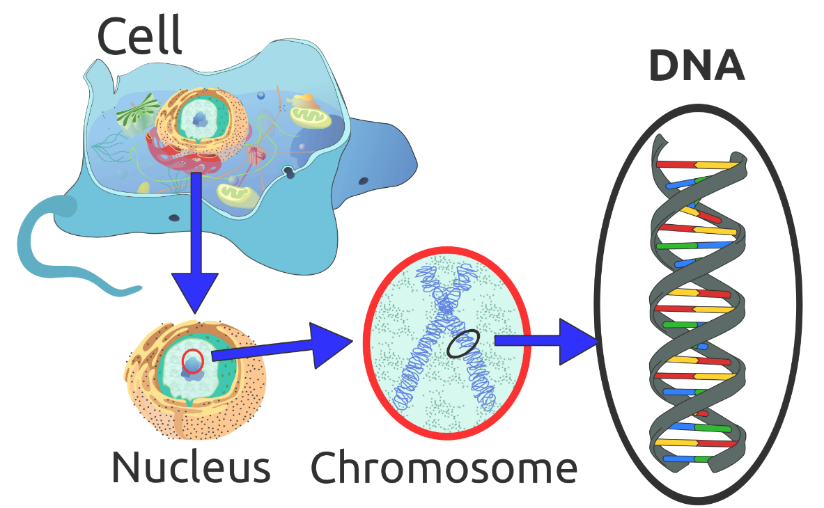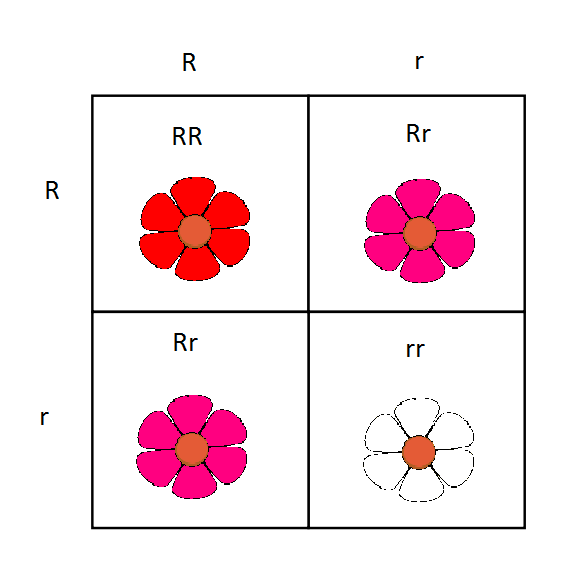3.3 What are Genes and Chromosomes?
Every single cell in our bodies, except for red blood cells (because they do not have a nucleus) contains deoxyribonucleic acid, or DNA, the unique material that serves as the building blocks for our genes. Genes are a segment of DNA. Imagine our DNA, genes and chromosomes as a lego set. The DNA are the individual pieces. As with lego pieces, each piece of DNA serves a specific function in the design of the gene. The genes are like the blueprints for the buildings. In our bodies, genes contain the information to determine features like our hair color, or whether our cheekbones resemble our mom or dad. Like the instructions for the lego set, the genes are how we get our unique look. Each completed minifigure or vehicle in the lego set is like a chromosome. When all 46 chromosomes come together, they represent a fully completed lego set, all of the people, buildings, and accessories in place. All of the pieces have fit together to complete the puzzle.

Figure 3.2. Diagram of a gene.
3.3.1 Chromosomal and genetic abnormalities
In the United States, there are approximately three million babies born each year (Martin et al, 2021). The majority of these babies are born with the typical 46 chromosomes. Roughly 33 in every 1000 babies, or about 3% are born with a chromosomal abnormality. Chromosomal abnormalities are either structural or numerical. With a structural abnormality, a part of the chromosome does not duplicate correctly, resulting in missing information and an incomplete chromosome. Numerical abnormalities result when there are too many or too few chromosomes. Abnormalities may occur as early as conception. In many cases, a chromosomal abnormality will make it impossible for the fetus to survive, resulting in a spontaneous termination, more commonly called a miscarriage. According to the American College of Obstetricians and Gynecologists, 10 out of 100 known pregnancies end in miscarriage.
One risk factor that increases the risk of a chromosomal abnormality is the exposure to external factors that compromise fetal health, also known as teratogens. Some examples of teratogens are alcohol, smoking, exposure to pesticides and other chemicals, and use of pharmaceuticals, both prescription and illicit substances. Later in the chapter we will look more closely at how teratogens impact maternal and fetal health.
3.3.2 Genotype, Phenotype, and Heredity Factors
Do you like cilantro? You may love it and add it to all of your favorite dishes. You may hate it and think it tastes like soap. What you may not know is that the taste of cilantro is an inherited trait, determined by your genes. In fact, genes influence a lot of who we are, from what we look like to whether we are right or left handed. Even some of our preferences (such as whether you like cilantro) are impacted by our genetic makeup.
The genes we inherit from our parents make up our genotype. Because we get genetic material from both parents, it is possible to receive the same version of a gene from each. We call this a homozygous genotype. In this instance, we will display the characteristic because it is the only genetic option available. But it is also possible to get different versions of the same gene, such as the gene for eye color, which is called heterozygous. Eye color is an example of a trait that can be either homozygous or heterozygous. Blue eyes only occur if a person gets the same recessive gene from both parents. Brown eyes could result from either homozygous or heterozygous genes. If a person got a recessive blue eye gene from one parent, but the dominant brown eye gene from the other, they would have brown eyes, but a heterozygous genetic trait. If a person received a dominant brown eye gene from both parents, they would have brown eyes, and a homozygous genetic trait. In this instance, we cannot display both genes, so one gene will be visible or active, while the other will not. Dominant and recessive genes influence which genes are expressed, called the phenotype. Dominant genes express themselves in the phenotype even when paired with a different version of the gene, while their silent partner is called recessive. Recessive genes express themselves only when paired with a similar version gene. If you sneeze when you are exposed to the sun, you can thank your parents- both of them, because the gene that causes photic sneezing is caused by a recessive gene! Freckles and red hair are also recessive, which means that in order for you to have them, you must receive the gene from both parents.
As we learned earlier in this chapter, many characteristics are polygenic, meaning they result from several genes. In addition, the dominant and recessive patterns described above are usually not that simple either. Sometimes the dominant gene does not completely suppress the recessive gene and this is known as incomplete dominance.
3.3.2.1 A Deeper Dive into Genetics
Our understanding of genetics has evolved throughout centuries of scientific inquiry. Much of what we know about how genetic traits work can be traced back to the work of Gregor Mendel, who first discovered the concept of dominant and recessive genes through observing hybrid pea plants. He discovered that when he bred certain species of plants together, specific traits seemed to be passed on more than others (dominant) and that other traits were only passed on when both plants shared the trait (recessive). Of course, humans are much more complicated than pea plants, but the concept proved to be true, albeit a little more nuanced. Reginald Punnett was also an important figure in biogenetics. He created the first tool for predicting the probability of hereditary traits being passed on. The Punnett square uses a simple two by two square and basic multiplication to predict the offspring’s probability of a specific trait based on the possible combinations of two parents’ genetic information.
Check out the link for more information on how dominant and recessive genes interact. You can even play with this Punnett square calculator and see probabilities of gene makeup.

Figure 3.3. A Punnett Square.
3.3.3 Epigenetics
Earlier in the chapter we learned about how nature and nurture interact to help shape our development. We have learned that our genetic material is inherited (genotype) and that genes are expressed in several ways (phenotype). A gene may be turned on (expressed) or turned off (not expressed) based on environmental factors. To help us think about how epigenetics is related to gene expression, let’s think about baking cookies. A recipe of chocolate chip cookies, using all of the same ingredients, can present differently each time. The phenotype of the cookie changes, even though the genes do not. How is this possible? Environment, of course! In this case, the phenotype of a cookie will change based on the environmental changes in the ingredient butter. If you want a fluffy, soft cookie with a cake-like texture it is best to soften the butter before mixing into the batter. But perhaps you prefer a cookie that is thin and chewy in the middle, but gets crispy around the edges. If so, you need to melt the butter before mixing the dough. The same ingredients are in the recipe, but the phenotype (how that cookie bursts forth from dough into cookie) is different. The condition of the butter (environmental factor) changes how the cookie presents (phenotype) with. By altering the environment around the butter, it changes its state from hard to soft to melted. This changes how the cookie develops in the oven and the finished product that comes out (phenotype), even though the ingredients (the genotype) stayed the same.
Our genetic material is determined at conception. But the conditions after conception may alter how genes present. Even though there is no actual DNA change, environmental conditions may prompt some genes to be switched on, or others be switched off. The genetic potential is reacting to the environment. Without actually changing the DNA, the cells “remember” the environmental conditions, and prepare future genes to respond, creating a heritable change that comes from outside of the gene itself. Some examples of epigenetic changes can be found in nutrition and diet, such as increased risk of diabetes or obesity, or increases in anxiety and attention deficit among people experiencing chronic stress (Toperoff et al, 2012; Nilson et al., 2014). Like the butter in cookies, the DNA remains the same, but the conditions of its environment means it may look and feel different based on external factors.
3.3.4 Licenses and Attributions for What are Genes and Chromosomes?
“Chromosomes and Genes” by Terese Jones is licensed under CC BY 4.0.
Figure 3.2. [1] “Eukaryote DNA” by Radio89, Wikimedia Commons, is licensed under CC BY-SA 3.0 / A derivative from the original work.
Figure 3.3. “Incomplete dominance punnett square” by Adabow, Wikimedia Commons, is licensed under CC BY-SA 3.0 / A derivative from the original work.
